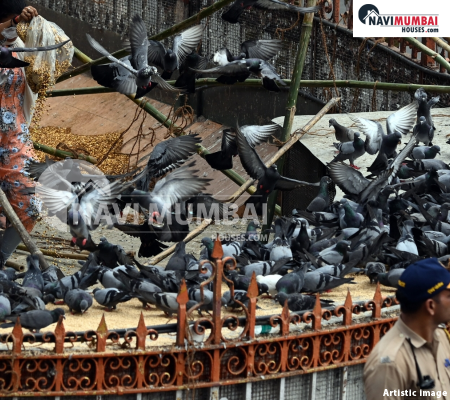
In a major shift in Mumbai’s urban wildlife policy, the BMC is planning to designate four specific sites for pigeon-feeding — behind the July 2025 ban on traditional “kabutarkhanas” (public pigeon-feeding places) across the city. The proposed sites are at Sanjay Gandhi National Park (SGNP), Aarey Colony, a mangrove patch in Wadala and the Gorai area.
The move aims to balance public health concerns cited by the Bombay High Court, and religious sentiment around pigeon-feeding practices, especially within the Jain community.
What’s Driving It & What Are the Issues
A. Why the Ban Happened
In July 2025, the Bombay High Court issued directives to clamp down on public pigeon-feeding zones, citing health hazards from pigeon droppings and potential fungal infections among people frequenting such spots. The BMC followed up by sealing multiple kabutarkhanas including the prominent one at Dadar.
B. Why New Sites Were Identified
To preserve the religious and cultural practice of pigeon-feeding, a delegation from the Jain community met the BMC Commissioner and requested alternate zones. The BMC then proposed four sites that are away from dense residential zones, reportedly to minimize health risks and civic-infrastructure burden.
C. Why the Choice of Locations is Controversial
While SGNP and Aarey may be less crowded, they lie within or near ecologically sensitive zones: buffer areas for the national park and green corridors. Environmentalists warn that introducing large-scale pigeon-feeding could upset the local ecology, generate waste, attract predators, and impact native birds.
Religious groups, on the other hand, argue that pigeon-feeding is a longstanding practice and the ban infringes on cultural rights.
Implications & Stakeholder Viewpoints
For Religious Communities
-
The designated-zone proposal offers a compromise: allowing pigeon-feeding but in less disruptive locations.
-
However, some leaders feel the proposed sites are remote or inconvenient, raising concern about actual accessibility.
For Environmental & Civic Authorities
-
The shift signals a more regulated approach—rather than blanket banning, the BMC is trying site-specific regulation.
-
But ecological risk remains: feeding large flocks of pigeons may alter food chains, create sanitation issues, and disturb sensitive park zones.
For Local Residents
-
Residents near the new sites may welcome reduced pigeon-activity in dense areas, but those near the proposed zones may worry about noise, droppings or increased foot traffic.
-
Civic maintenance costs may increase if these alternate zones require infrastructure (cleanup, waste management, surveillance).
For Real Estate & Urban Planning
-
These designated zones could influence land-use and neighbourhood perception. Areas closer to feeding sites may see changed footfall patterns or public-space dynamics—something relevant for homeowners or developers in those zones.
-
The move indicates growing pressure on urban ecology and cultural practice, which may become planning considerations going forward.
What to Watch & What Citizens Should Do
-
Official finalisation of sites — The BMC is yet to issue a public list or detailed plan; monitor for when the zones are legally notified.
-
Clearance & regulation — Ensure that environmental clearances, waste-management plans and neighbourhood consultations are part of the proposal before operations start.
-
Monitoring & enforcement — Check whether feeding is restricted to the designated zones and whether old-spots remain sealed.
-
Local participation — Residents and community groups should engage in the process: site-selection, design, oversight of operations to minimise nuisances.
-
Real-estate implications — If you own or plan property near any proposed zone, assess how increased public access or wildlife-related activity might affect the environment or value.
Conclusion
The BMC’s plan to shift pigeon-feeding from public urban spots to designated zones at SGNP, Aarey, Wadala and Gorai reflects a nuanced attempt to reconcile public-health, ecological and cultural concerns. But the devil will be in the details: execution, site-management, and impact on neighbourhoods and green zones will determine whether this policy becomes a model or a new flash-point. Urban India’s challenges often lie in balancing the city’s cultural practices with its environmental realities—and this is another case in point.
Visit Us: Navimumbaihouses.com or Call Us @ 8433959100
The post After Citywide Ban, BMC Proposes Pigeon-Feeding Zones in SGNP and Aarey appeared first on .

